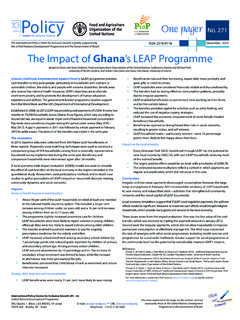Transcription of Bridging the Gap: Inclusive Growth 2017 Update …
1 Bridging the Gap: Inclusive Growth 2017 Update Report This work is published under the responsibility of the Secretary-General of the OECD. The opinions expressed and the arguments employed herein do not necessarily reflect the official views of the OECD. member countries. This document and any map included herein are without prejudice to the status of or sovereignty over any territory, to the delimitation of international frontiers and boundaries and to the name of any territory, city or area. This report was prepared under the leadership of Gabriela Ramos, Special Counsellor to the Secretary General and Sherpa. The preparation of the report was co-ordinated by the Inclusive Growth Unit headed by Romina Boarini, with contributions from the Economics Department, the Directorate for Labour, Employment and Social Affairs, the Directorate for Science, Technology and Innovation, the Directorate for Education and Skills, the Centre for Tax Policy and Administration, the Statistics Directorate, the Centre for Entrepreneurships, SMEs, Local Development and Tourism, the Directorate for Financial and Enterprise Affairs, the Directorate for Public Governance and Territorial Development and the Environment Directorate.
2 The statistical data for Israel are supplied by and under the responsibility of the relevant Israeli authorities. The use of such data by the OECD is without prejudice to the status of the Golan Heights, East Jerusalem and Israeli settlements in the West Bank under the terms of international law. 1. TABLE OF CONTENTS. Table of contents 2. Executive summary 3. Introduction 7. The Issue: The Rise of Inequalities 10. Understanding the rise in inequalities: Drivers and Consequences 25. Policies for Inclusive Growth 41. References 74. 2. EXECUTIVE SUMMARY. Global economic integration has been a source of prosperity for many years, but is coming under growing political pressure partly due to uneven sharing of the benefits of Growth . It is perceived as one of the causes of increased inequalities and a source of disempowerment for individuals and communities. The OECD has long highlighted the necessity of rethinking the traditional model of economic Growth to put people's well-being centre-stage and has launched the Inclusive Growth Initiative in 2012 to develop a strategic policy agenda for feeding this new vision of Growth .
3 The OECD efforts on the Inclusive Growth agenda have culminated in the 2016 Ministerial Council Meeting Declaration on Enhancing Productivity for Inclusive Growth . The Declaration highlighted that an effective response to address the twin challenge of fostering productivity Growth and reducing inequalities requires leveraging on technological advances and innovation to boost economies and ensure that higher productivity Growth translates into broadly shared gains in well-being. This report provides an Update of the OECD. activities undertaken in response to the Declaration, building on major OECD flagships such as Going for Growth 2017, Tax and Inclusive Growth , updates of the Divided We Stand analysis and various other OECD pieces. Over the last couple of decades, inequalities of income have risen or remained stubbornly high in various OECD countries as did wealth and well-being inequalities, although these general trends mask great disparities across countries and regions.
4 Over the past two decades, income inequality has widened or plateaued at a high level in several OECD countries, often with large regional discrepancies, as richer households have pulled away from their middle and lower income peers. The trend is more mixed for emerging economies, though the absolute levels of inequality remain much higher than in OECD. countries. Wealth is significantly more unequally distributed than income in countries where comparable information is available. In addition, since the crisis, multidimensional living standards of the poorest households have trailed behind, with those in the middle faring a little better, whilst those at the top have seen substantial improvements. How do we go about reducing inequalities? To improve the opportunities of the next generation we must address the unequal outcomes of current generations. Child development is key for sustaining well-being at every stage of life. Yet, for the most disadvantaged children, multidimensional inequalities start accumulating early and achievement gaps widen throughout schooling, making it harder for them to climb the socio-economic ladder.
5 While parental educational background has a particularly strong influence on children's opportunities to pursue quality education in many OECD countries, poor children manage to overcome family background barriers and obtain high educational outcomes in some countries. Addressing the spatial dimension of inequalities between urban and rural areas would have a great impact on reducing overall inequalities. There are large income differences between urban and rural areas in both OECD countries and emerging economies. Income inequality is also higher in cities than in other locations and tends to be even higher in the largest cities, as they attract highly skilled workers and the most productive firms. Regional disparities concern many well-being dimensions, not only income. Such disparities tend to be larger when broader living standards measures are considered. 3. Research shows that some drivers of prosperity may have differentiated impacts on inclusiveness outcomes, but governments can work to settle in a virtuous circle where Growth translates into higher well-being for all and inclusiveness underpins stronger Growth in a sustainable manner.
6 Fiscal redistribution through taxes and transfers plays a crucial role in containing the impact of market income inequality on disposable income, but fiscal policy has become less redistributive over time. In some countries, distributional objectives were not explicitly embedded in mainstream economic policies, but were seen only as part of the social agenda, and looked at ex-post issues. More broadly, a number of longstanding structural transformations to the way OECD economies function, combined with policy settings, have likely fuelled inequalities. These include: technological change and digitalisation in connection with economic globalisation, several aspects of financial deepening and functioning of financial markets and job polarisation. Digitalisation and globalisation have had many profoundly positive impacts, but policies could and should do better to help those directly affected by the associated changes, thereby mitigating the widening of socio-economic gaps in countries where inequality is very large.
7 Digitalisation and globalisation connect people, enterprises, cities, countries and continents in ways that vastly increase individual and collective potential. They provide entirely new ways for people to connect, socialise, collaborate and participate in societies; they enable the production of more and better products and services at cheaper prices, thus increasing consumers' welfare; they foster the diffusion of knowledge and technology; they spur innovation, productivity and Growth and have allowed millions of people in developing and emerging economies to escape poverty and improve their living standards. Yet, capital flows and global economic integration have also increased the difficulty for governments in taxing mobile capital income, with possible detrimental effects on inclusiveness. Digitalisation might also have impacted wage inequality and productivity Growth , by exacerbating the divide between highly and low skilled workers. Globalisation and digitalisation impacts are among the factors responsible for a growing disconnect between productivity Growth of firms standing at the frontier and that of laggards.
8 While some of these mechanisms have been documented by recent OECD work, more research is needed to further corroborate these findings. More work should be undertaken to assess all the consequences of inequalities, including for long-term Growth , as they may be large. Inequalities lower investment in human capital among the bottom 40%, jeopardising productivity Growth . Rising inequalities also put further pressure on public social budgets, as often going hand in hand with larger transfers and smaller revenues. Finally, high inequalities may also be hindering trust in public institutions, constraining governments' capacity to act and weakening structural reform implementation efforts. While some of these mechanisms have been thoroughly documented by OECD work, there remain areas where further efforts are required to fully appreciate the consequences of inequalities. The cross-cutting challenge presented by the persistence of multidimensional inequalities and stagnating productivity underlines the need for a profound reappraisal of the Growth narrative that was focused on maximizing material well-being, on average Growth rates, and on efficiency of markets.
9 This reappraisal ought to entail a renewed look at the rules which govern our economies and the role of national governments in designing and enforcing those same rules, but focusing on people, and outcomes that matter to people. Such an exercise should span across an array of domains essential for promoting Growth and helping all individuals and firms to fulfil their potential: from making financial markets work better as channels of capital to productive activities, to looking again at the role of public policies for enabling and promoting innovation, and to reinvigorating market competition to unleash business 4. dynamism and level out the playing field for all firms. It requires considering the distributional impacts of economic policies, and prioritising policies that will benefit the bottom 40%. The importance of governments, institutions and businesses in fostering Inclusive Growth A central pillar of this new policy setting concerns the role that national governments should play to enable individuals to flourish throughout their lives.
10 If the government is to rise to the challenge of addressing unequal outcomes and to prevent disadvantage cascading down generations, whilst acting as a catalyst for stronger productivity Growth , it needs to be reconfigured to serve its citizens as a launching pad. In practical terms, this will call for a re-orientation away from a risk-only approach to welfare provision, towards a lifelong enabling platform that furnishes individuals with capacity enhancing assets in the form of human and social capital, good health and active support in labour markets and that builds strong foundations for learning and adaptation for life and through life. Efforts to ensure that all individuals have the opportunity to lead meaningful and productive lives are reliant on a thriving business sector. Businesses are uniquely placed to provide employment opportunities, foster individual well-being at the work place, contribute to the development of skills, and promote the creation and dissemination of knowledge and technology.
















